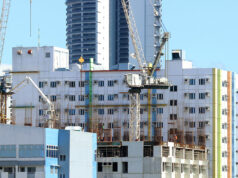March inflation could have topped 4%
By Melissa Luz T. Lopez
Senior Reporter
HEADLINE INFLATION likely quickened further in March to breach four percent amid rising fuel and power costs, analysts said in a BusinessWorld poll, noting that tax reform and a weaker peso have stoked price pressures.
A poll among nine economists last week yielded a median forecast of 4.2% under the 2012 base year, which is a fresh peak for monthly inflation. This compares to the 3.9% rate logged in February and the adjusted 3.1% for March 2017.
If realized, this would settle above the 2-4% target range set by the Bangko Sentral ng Pilipinas (BSP), but will fall within the 3.8-4.6% forecast given late last week.
Under the old 2006 base, inflation likely clocked 4.75%.
The central bank has cited a higher power generation charge and retail pump prices due to the depreciation of the peso as upside pressures, partly offset by lower costs of cooking gas.
The Philippine Statistics Authority will release official inflation data on Thursday.
Inflation last pierced the four-percent mark — using the 2012 base — at 4.2% in July and August 2014.
Guian Angelo S. Dumalagan, market economist at the Land Bank of the Philippines, said faster increases in the costs of petroleum, food and non-alcoholic drinks likely led to the overall surge in prices. “The costs of these goods accelerated, fuelled by the hike in excise taxes under the TRAIN law and the depreciation of the peso, which made foreign goods and services more expensive in local currency terms,” Mr. Dumalagan said via e-mail, referring to the impact of the Tax Reform for Acceleration and Inclusion Act that took effect Jan. 1.
TRAIN, enacted as Republic Act No. 10963, imposed an additional P2.50 excise tax per liter of diesel and P3 per liter for kerosene, which came at a time of three-year highs for world crude prices. The new law also introduced additional taxes on cars, coal, sugar-sweetened drinks and a host of other items that likely drove up prices of other widely used goods and services.
Other analysts said higher prices of rice, fish, meat and vegetables drove up food costs last month.
At the same time, the peso weakened to a fresh 11-year-low last month as it continued to trade above P52 versus the dollar.
Nomura economist Euben Paracuelles expects inflation to have settled at 4.2% in March, and will likely keep moving faster: “I still think inflation remains on an upward trajectory driven by the combination of a pickup in fuel & electricity prices, the impact of ‘TRAIN’ tax reforms continuing to feed through, and still-strong demand conditions.”
The BSP said they see inflation peaking within July-September, before averaging at 3.9% for the full year.
With inflation further picking up pace, more analysts are now considering that a rate hike may happen sooner than later, with some betting the change in rates as early as next month.
“Though the current monetary policy settings are deemed to be appropriate, thus far, I think there’s a growing chance of a modest monetary tightening within the year, especially if inflation will continue to accelerate and depreciation pressures on the peso will be persistent,” said Angelo B. Taningco, economist at Security Bank Corp.
Rajiv Biswas, chief economist for Asia Pacific at IHS Markit, said the case for a rate hike “will become more compelling” by May should inflation remain elevated and economic growth robust.
BSP Governor Nestor A. Espenilla, Jr. has acknowledged that inflation will be “accelerated” within 2018, but noted that price pressures “will come down soon enough.” The central bank sees inflation settling back within target and averaging three percent.




